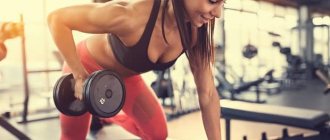Basic types of isometrics in sports
These trainings are divided into several types, depending on the technique of execution.
- Static-isometric - imply the greatest muscle tension, without body movement, while resisting an insurmountable obstacle, for example, an attempt to move a wall.
- Weight training, in which you need to freeze in one position. For example, half squats with dumbbells.
- Exercises with the greatest burden.
- Isotonic exercises - during muscle contraction, their length also changes. Such exercises need to be done dynamically.
There are also three groups of similar training: deadlifts, bench presses and half squats.
Disadvantages of Isometric Exercises
- Sometimes static exercises lead to noticeable shortening of the muscles. To avoid this, you need to choose the right set of exercises, or better yet, consult a professional who can suggest the technique and give advice. You can find such a professional on our service. Create an event, describe the need and wait for feedback from trainers.
- Isometric exercises can cause a reduction in muscle motor abilities and reduce the speed of movement.
- They do not develop coordination, unlike other, more traditional and classical exercises.
Remember that isometric exercises must be combined with dynamic exercises. These two types of training compensate for each other's shortcomings and help create relief for your body. We wrote, for example, about chest exercises
,
about training on the horizontal bar
and
proper training on the uneven bars
.
What are the main advantages and disadvantages of isometrics
So, let's start with the disadvantages of these workouts:
- Such training, like static exercises, is extremely contraindicated for people with problems with blood pressure and the cardiovascular system in general. And if you don’t have such problems yet, then there is a risk of getting them. But this is not a fact, but simply a probability.
- If you are a bodybuilder and your goal is to gain more muscle, then isometric muscle training is definitely not for you. It is aimed more at increasing strength and developing tendons rather than muscle mass. Such exercises, of course, partially help with this, but still they cannot replace dynamic training.
Well, that's probably where the shortcomings end. There are many more benefits.
- Ease of implementation and the need for special training equipment.
- Increased muscle strength.
- If done regularly and correctly, you can count on losing weight.
- Development and strengthening of various muscle groups, including deep ones.
- You can do isometric exercises at home.
- You don't need much time to rest.
How to build an isometric workout
A program for those who are ready to find 20 minutes of time to study every other day:
- leg press;
- vertical traction;
- isometric push-ups;
- static press with holding the barbell for 10 seconds with outstretched arms (3 sets);
- isometric bench press with partial amplitude - lower the barbell by 20 cm and work with less weight (3 x 4).
- close grip bench press from a lying position to increase triceps strength or dips.
For beginners, 2 technicians are enough. In each subsequent month, add one and bring them to six.
How to do the exercises correctly
There is a small number of rules, following which you can achieve maximum efficiency from your training and minimize all the risks associated with them, for example, injuries.
- In most cases, the duration of one approach is 6-12 seconds.
- The break between trips should be from 30 seconds to a minute.
- The full training cycle is about 20 minutes.
- You should strain your muscles to the maximum (not for beginners), but smoothly and gradually, and not abruptly.
- For the best results, it would be a good idea to combine isometrics with dynamic exercises.
- Be sure to do a light warm-up before your workout.
What is the Zass system?
The point is that the athlete strives to perform an action that obviously exceeds physical capabilities. For example, lifting a car off the ground. Although the example is exaggerated, the principle is clear. The main thing is that while working in isometric mode, tension in the muscles gradually increases, and after reaching a peak and a short delay, it is released. The duration of Samson's exercises depends on the degree of load - the time varies between 3-12 seconds. If you apply up to 70% force, you need to pause for 10 seconds; with full effort, 3 is enough. No more than 15 minutes are allotted for training.
Methodology of Alexander Zass
It is impossible not to pay attention to the technique of such an outstanding person, with amazing strength and endurance, who literally broke chains, lifted horses and lay down under a truck with coal. Let us consider here the isometric exercises of Alexander Zass and several examples of practical training by Iron Samson, aimed at strengthening the tendons. After all, according to Zass, it is thanks to tendons, and not bulky muscles, that your strength increases.
For gymnastics equipment, you will need an ordinary, thin chain and loop handles for them, which you can make yourself from improvised means. If there are none, then at worst you can simply twist it around your hand, or you can take a rope or belt instead of a chain.
- Hold one end of the chain tightly with your outstretched left hand, and bend your right hand at the elbow and grasp the other end. Try to break or stretch it in this way. Switch hands and repeat the approach.
- Extend your arms above your head and hold the chain approximately shoulder-width apart. Stretch it in this position, while tensing not only the muscles of your arms, but also the muscles of your chest and back.
- Take two chains with loops at the ends. Place your feet into the loops and begin to stretch the chain with your hands.
- Place the chain behind your back, at the level of your shoulder blades, and stretch.
- Do a lying position and put your hands through the loops, and bring the middle of the chain behind your neck and try to break it.
The theory of isometric exercises by Zass (Samson) and Bruce Lee
Samson proved by personal example that human strength lies not in muscles, but in tendons. And even a person with a modest physique is capable of demonstrating incredible capabilities. Alexander Zass himself was of modest height - only 165 cm and light weight - 65 kg. But having trained the strength of his tendons, believing that they were of decisive importance, Samson achieved amazing results.
It got to the point that he could lift a horse, break chains, do somersaults with weights and defeat the strongest and largest opponents. For all his achievements he received the nickname “Russian hero”. And at the same time, Samson still had to perform dynamic exercises to build muscle mass. But as he himself said, this was done more for visual appeal than for results.
The training set he developed includes a number of isometric exercises. At the same time, which is convenient, the exercises can be performed both at home and even in a work environment (for example, trying to lift yourself along with a chair by holding the bottom of the seat - trapezius works, or trying to lift a table by resting your palms on the tabletop from below - biceps works).
Bruce Lee Method
Let's not neglect Bruce Lee's famous isometric exercises here. Despite the fact that for this outstanding martial arts master in the past, isometrics was only a small part of his entire range of activities, but he valued its role very highly. Let's look at a few specific examples of his training. However, such isometric gymnastics will require additional sports equipment in the form of a fixed crossbar.
- Secure the bar approximately 10 cm below the level of your outstretched arms. Grasp it with your hands shoulder-width apart and with maximum effort push the bar up for 6-12 seconds. The same execution time will be required for the examples below in this section.
- Place the bar at chin level and press it forward in the same way.
- Place the bar approximately 10 cm below the groin. With your elbows slightly bent, pull it up. The back should remain straight.
- Place the bar just below your knees and take a shoulder-width grip. With your head slightly tilted back and your back straight, pull up with maximum effort.
- The bar is placed at shoulder level when you are in a squat position. Grasp it with your arms and try to rise.
- Install the horizontal bar slightly below (10-15 cm) shoulder level. Sitting under it, push up without lifting your heels from the floor and keeping your back straight.
Features of the method
Thanks to the unique Iron Samson system, which is aimed not at hypertrophy, but at increasing tendon endurance, many can achieve such results. According to the author, large biceps are not considered an indicator of strength, just as a bulging belly is not a sign of healthy digestion.
It is appropriate to recall the achievements of another strongman, Bruce Lee . During his short sports career, the martial artist managed to build muscles that were compared to warm marble. Although he used many different techniques, isometric exercises were always listed as number 1 for Bruce Lee. These are:
- different types of bench presses;
- finger lifts;
- deadlift;
- quarter squat on the bar;
- "frog".
Training complex for various parts of the body
The above examples are mainly suitable for the muscles and tendons of the arms. We will describe below a set of isometric exercises for other parts of the body and give a few more examples that can be performed at home or in the office, without any special sports equipment.
To strengthen the buttocks and legs
- While sitting at a table, cross your legs. Use your upper knee to push the table upward.
- Standing on one leg, bend the other at the knee and hold your foot with your hand. Press your foot down as hard as you can.
- Sitting on a chair, straighten your legs, place them one on top of the other and lift them up. Press your lower leg up and your upper leg down.
To strengthen the press
- Sitting on a chair, clasp your hands behind its back. Try to lean forward like this.
- Lying on your back, place your hands on the floor. Raise your outstretched legs and hold for 6-12 seconds. Then lower your legs and raise your back to 45 degrees and hold in this position.
For the back
- While sitting on a chair, bend over and squeeze the legs of the chair with your hands. Try to pull them up.
- Sitting on a chair, tuck your legs and clasp your hands around your hips. Without bending your arms, try to lift your shoulders up.
For the chest
- Sit down and clasp your bent arms in your palms at chest level. Squeeze them vigorously for 6-12 seconds.
- With your arms extended in front of you, clasp your hands together. Try to break this lock.
- Clench one palm into a fist, and with the other palm press firmly on the fist, extending your arms at chest level.
For neck muscles
- Place your hands behind your neck and clasp them there. With maximum effort, try to pull your neck forward, while your neck should resist the pressure on it.
- Sitting on a chair, throw your head back and rest your elbows on the table. Place your chin in your palms and try to lower your head.
- Do the same, only rest your forehead on your palms instead of your chin.
Well, we looked at many different trainings. We hope that this information was useful to you and these classes will be a good help for you in developing the strength of your muscles and tendons. Good luck in the gym and beyond!
Technique of conducting classes
Of course, in order to achieve results and not waste energy in vain, it is important to learn the correct technique for doing the exercises. There are a number of tips that will help you do everything right. First, before training, you need to warm up and stretch to warm up your muscles and tendons. Secondly, it is important to practice proper breathing. The exercise should be performed only while exhaling.
Strength needs to be increased gradually, without sudden jerks. If during the process you feel a sharp pain, then you need to stop, take a break, and then try again, only more carefully.
You should not make an effort or stay in a static position for long. Then you can take a short rest and move on to the next approach.
Due to the large loads on the muscles, the total duration of isometric training, as a rule, does not exceed 15 minutes. But during this time the athlete manages to do several approaches of several repetitions for different muscle groups.
The number of repetitions for each exercise should be from 2 to 5. Moreover, the effort should increase each time. Let's say, with three approaches, you should do a minimum effort of 50% for the first time (to warm up). The second time, make an average effort - 75%. And for the third and last time, make the maximum effort, giving 100%. If you follow this system, isometric training will become much more effective.
The importance of the abdominal muscles
Even as children, testing each other's abs, we showed respect to those whose muscles could withstand the blow. And now it is very important for every athlete and fitness enthusiast to have six-pack abs. And to get them, people go on diets, go to gyms, and go on a treadmill. However, there are more acceptable loads and exercises for the abs. All kinds of lifts of the torso and legs, twisting are great for working on yourself. Plus it won't take too much time. They only require consistency in execution. The best way to get six-pack is considered to be isometric abdominal exercises. Daily isometric exercises will keep your body fit, even if you lead a sedentary lifestyle. Exercises for the abdominal muscles against the background of a lack of amplitude will help you develop strength and achieve perfect abs. So, it’s worth talking about what isometric gymnastics is, the exercises of which will be described below.
Static abdominal training (second round)
Static exercises are allowed even with limited physical activity, but be sure to consult a specialist before starting exercise. Don't forget that to achieve results you will need regular training, sleep patterns and proper nutrition.
Second round of static exercises:
- Superman in elbow plank (right leg)
- Superman in elbow plank (left leg)
- Hand fold to feet
- Wide bar
- Corner with bent legs (right leg bent)
- Corner with bent legs (left leg bent)
- Hyperextension with arms out
- Plank on all fours with hands touching (right hand)
- Plank on all fours with hands touching (left hand)
Superman in elbow plank
What are the benefits: Isometric exercise engages the muscles of the core, back and shoulder girdle. The load is also distributed across the muscle groups of the legs. This is a super exercise for complex work of the whole body!
How to perform: The starting position of the exercise is a classic variation of the plank with emphasis on the elbows and toes. The back is straightened, the stomach is pulled in, the head looks ahead. Remaining in this position, lift one leg and arm in the opposite direction, straightening them. To work the muscles evenly, perform the exercise on both sides, that is, change the supporting limbs.
How to simplify: Lift only your leg off the floor, leaving both forearms on the floor.
Hand fold to feet
What is the benefit: The main load of this static exercise falls on the abdominal muscles, which will literally burn. The back is also worked on.
How to do it: The standard fold variation is performed from a supine position. Stretch your legs, point your arms straight up. From this position, perform a fold, trying to reach your ankles with your fingertips. Do not overstrain your neck while performing the exercise to avoid neck discomfort the next day. Only the lower back should be on the floor, with the shoulder blades raised.
How to simplify: You can reduce the load during exercise by softening your knees or bending your legs at a right angle.
Wide bar
What are the benefits: This isometric exercise allows you to pump up your abs and tighten your stomach. The static load of the exercise also falls on the muscle groups of the back and shoulder girdle.
How to do it: The starting position of the lesson is a variation of the plank with support on straight arms and toes. From this position, move your arms forward as far as possible so that you can comfortably support your own weight. The legs maintain their position while remaining straight. The head also looks forward, the back is straight, and the abs are tense.
How to simplify: You can simplify the exercise by moving your hands closer to you in a standard hand plank position.
Corner with bent legs
What are the benefits: Abdominal exercise also engages the muscle groups of the back, which helps strengthen the core. Static load falls on the arms and legs.
How to do it: The starting position of the workout is sitting on the mat. Lean your body back slightly, arms extended in front of you. One leg is fully straightened and raised low above the floor. The other leg is bent at the knee and also suspended. Keep your head looking forward, do not strain your neck too much. Pull your stomach in. Don't forget to repeat on the opposite side.
How to make it easier: You can make this isometric exercise easier by softening the knee of the extended leg or bending it slightly.
Hyperextension with arms out
What are the benefits: This simple and very useful static exercise loads the back and lumbar region, helping to get rid of folds on the back, improve posture, and strengthen the muscle corset.
How to do it: Take a lying position with your stomach down on a gymnastic mat, spread your straight arms in opposite directions. Lift your body up, trying to lift your chest off the floor. Unlike hyperextension in the first circle, in this version the legs remain on the floor, which makes it easier to perform the exercise. Advanced practitioners can lift their hips off the floor.
How to make it easier: You can extend your arms along your body instead of spreading them in the opposite direction, which will make this isometric core exercise much easier.
Plank on all fours with touching hands
What is the benefit: The final exercise of our workout has a comprehensive effect on the whole body. Most of the load falls on the shoulder girdle, core and leg muscles. The muscles of the whole body will burn!
How to do it: To perform this isometric exercise, get into a plank position on all fours. That is, you need to lean on straight arms, placing them under your shoulders, and legs bent at an angle of 90 degrees, standing on your toes. Your knees should be under your hips. From this position, move one hand to the opposite shoulder. Do not lift your pelvis or raise your knees too high from the floor. Repeat on the other hand for a finishing approach.
How to make it easier: Stay on all fours, without lifting your hands from the floor.
5 reasons to do isometric training:
- Such workouts are easy to follow, and static exercises are no less effective in terms of load compared to grueling dynamic training.
- In addition to strengthening muscles, static exercises also help strengthen ligaments, tendons, joints and the spinal column.
- Isometric training is very “economical”: it takes less time and requires less effort.
- If you follow the exercise technique, the risk of injury is minimized, unlike strength and cardio exercises.
- To train, you do not need additional equipment and a lot of space in the room.
Perform the proposed static exercise program 3 times a week, on the remaining days you can perform other workouts:
- Cardio workout to burn fat
- Interval training for legs and buttocks
- Fat burning workout with an emphasis on the stomach
- Abs workout (top 30 exercises)
- Plank based workout
- Arm workout with dumbbells











